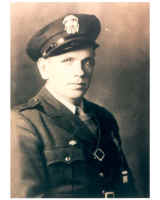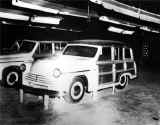(1946 & 1947)
|
1946 By early this year, the Huntsville Arsenal Engineer had leased more than 5000 acres of arsenal land for the growing of small grains. January to June 1946 Several civilian barracks being used as bachelor quarters were adapted to family quarters. Because of the acute housing shortage prevalent in the city, Huntsville Arsenal made available all possible quarters to civilians. During this period, the post had 6 families of enlisted personnel, 1947 families of civilian employees, 20 single male civilian workers, and 23 single female employees occupying these quarters. January to June 1946 The mission of the Fifth Echelon Repair Shops for this period was to repack colored grenades to facilitate storage; recondition 4.2-inch chemical mortars, chemical mortar and ammunition carts, and M2-2 portable flamethrowers; and service portable flamethrowers and smoke generators. On 19 June 1946, a program of refusing 29,000 M7-CN grenades was added to the shop's workload. |
|
Another responsibility was added when Huntsville Arsenal was designated as a storage center for vast quantities of production equipment to be placed in war reserve. Because of the enormous demands placed on the arsenal for the warehousing of equipment and gas mask components, every available building was put in service as storage space. Manufacturing plants, fire halls, and open sheds were commandeered for this purpose. 9 January 1946 The Tennessee River reached flood stage and stayed flooded for 6 days. All roads to the Gulf Chemical Warfare Depot were blocked. After the water receded on 16 January, it was discovered that 100 yards of highway and 300 yards of railroad track had been washed away. Needed repairs totaled approximately $5000. 16 January 1946 The disassembly line of the gas mask plant began operations on this date. A total of 378,403 masks were disassembled and the parts used in the assembly of lightweight service masks. Operations on this line were discontinued on 29 April 1946, and all personnel were applied to the production of new masks. 11 March 1946 Practice work putting together lightweight service masks began at the gas mask assembly plant on this date. Actual production began on 18 March 1946 when 390 completed masks were run. Huntsville Arsenal made modifications to the assembly line that increased production to about 4000 completed masks per 8-hour shift as compared to the former contractor's 3288 masks per 24-hour-day line. The Gas Mask Assembly Plant ceased operations in September 1946. 15 March 1946 COL Carroll D. Hudson was reassigned away from Redstone Arsenal. 7 April 1946 Huntsville Arsenal and the Gulf Chemical Warfare Depot sustained significant damage from a severe hailstorm that swept diagonally across the installation from northwest to southeast. The storm severely damaged over 400 building roofs, more than 7000 windows, and numerous window frames and screens. Steam pipe insulation also was badly damaged. Many buildings, both manufacturing and quarters, were rendered unfit for occupancy until repairs could be made. This unusual circumstance affected the large turnover of civilian personnel in this period. The installation had to hire many temporary employees to make needed repairs to buildings and property that had been damaged by the storm. 14 May 1946 Memorandum 15, issued on this date, advised Huntsville Arsenal employees that effective 20 May the working hours of all personnel, except those on the night shifts, would be from 0700 until 1530 during the summer months. This change was based on an arsenal-wide vote conducted by the Employee Relations Department to determine the hours that the majority of employees preferred to work. July to December 1946 Several temporary buildings, declared surplus to the needs of Huntsville Arsenal and the Gulf Chemical Warfare Depot, were removed from the records of the Post Engineer. Among the buildings eliminated were the compound and all the buildings used as a Prisoner of War Camp as well as one barn and eight farmhouses acquired when the Army took possession of the arsenal reservation. 2 August 1946 The Gulf Chemical Warfare Depot was renamed the Gulf Chemical Depot. September 1946 A major RIF in the work force of Huntsville Arsenal occurred as a result of the Gas Mask Assembly program being discontinued. About 350 employees were separated. 4 September 1946 Huntsville Arsenal leased two chlorine producing plants to the Solvay Process Division of the Allied Chemical and Dye Corporation of Solvay, New York. This 5-year lease provided that the lessee would put the plants in an operating condition, and upon expiration of the lease, Solvay would put all the facilities in a standby condition. However, the terms of the lease were so general that it was often referred to as a "gentlemen's agreement" between the government and the corporation, with much room for different interpretations. The first Solvay plant began operations on 14 December 1946 and the other in May 1947. 1947 Personnel of the Huntsville Arsenal Police Department participated in Army Day ceremonies at the installation by serving as escorts and guides during the time that the reservation was open to visitors. This was the first time since the beginning of production that the general public had been allowed onto the arsenal reservation. |
|
January to June 1947 Higher headquarters required that the entire program to put all unused production machinery, equipment, and buildings at Huntsville Arsenal in standby storage be completed within this period. Protection and preservation against corrosion, weathering, and the effects of time and disuse were to be provided in accordance with existing directives. A total of 165 temporary per diem workers, representing all specialized crafts, were hired. These employees were released by 30 June 1947, after the program was completed on schedule and according to directives. 15 January 1947 The Gulf Chemical Depot was abolished and its functions were transferred to Huntsville Arsenal. The arsenal established the Gulf Chemical Depot Division to perform depot functions. It was renamed the Gulf Chemical Depot Activity on 26 March 1947. February 1947 Effective this month, 200 Third Army Area motor vehicles within a 150-mile radius of Huntsville Arsenal were satellited on the post's Motor Pool for field maintenance. 24 February 1947 Redstone Arsenal was placed on standby status, which meant that no further production would be carried out at that time. Only those employees who were necessary to provide essential maintenance of the plant as a reserve Ordnance arsenal were kept on, along with the necessary administrative force. 4 May 1947 Huntsville Arsenal reopened a 25-bed station hospital. June 1947 Farmland under lease on Huntsville Arsenal totaled 7120.39 acres. 17 July 1947 Fine Organics, Inc. signed a 5-year contract to store surplus materials in Building 721 on Huntsville Arsenal. |
|
11 August 1947 The Calabama Chemical Company and Huntsville Arsenal began negotiating a 15-year lease for three arsenal buildings previously used to manufacture thionyl chloride. The company planned to manufacture organic chemicals, insecticides, and related products. The lease went into effect on 19 March 1948. 30 September 1947 Huntsville Arsenal received verbal notification that the installation was being declared excess to Department of the Army (DA) needs. The prime mission of the arsenal was reoriented to the expeditious removal of production facilities and all stocks of munitions and materiel. The deadline for complete deactivation of the arsenal was set for the period March-June 1949. 29 December 1947 The Chief, Chemical Corps was advised of the Secretary of the Army's decision to declare Huntsville Arsenal excess to the needs of the Chemical Corps. |
The Pre-Missile Era: Introduction, 1941 , 1942 , 1943 , 1944 , 1945 , 1946 & 1947 , 1948 & 1949



